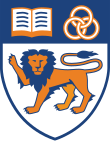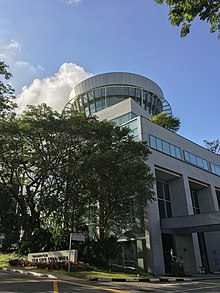
A | B | C | D | E | F | G | H | CH | I | J | K | L | M | N | O | P | Q | R | S | T | U | V | W | X | Y | Z | 0 | 1 | 2 | 3 | 4 | 5 | 6 | 7 | 8 | 9
 | |
Former names | Straits Settlements and Federated Malay States Government Medical School (1905–1921) King Edward VII College of Medicine (1921–1949) University of Malaya, Singapore campus (1949–1962) University of Singapore (1962–1980) Nanyang University (1956–1980) |
|---|---|
| Type | Public research university |
| Established | 3 July 1905 (as King Edward VII College of Medicine) 8 August 1980 (as National University of Singapore) |
Academic affiliations | ACU, IARU, APRU, Universitas 21, GEM4, AUN, ASAIHL, APSIA, McDonnell International Scholars Academy,[1] UAiTED |
| Endowment | S$6.46 billion (2020)[2] (US$4.81 billion) |
| Chancellor | Tharman Shanmugaratnam |
| President | Tan Eng Chye |
| Provost | Aaron Thean |
Academic staff | 2,555 (2018)[3] |
| Students | 35,908 (2018)[3] |
| Undergraduates | 27,604 |
| Postgraduates | 8,304 |
| Location | Queenstown, Singapore 1°17′44″N 103°46′36″E / 1.29556°N 103.77667°E |
| Campus | Urban, 150 ha (370 acres) |
| Colours | NUS Orange, NUS Blue[4] |
| Website | www |
 | |
The National University of Singapore (NUS) is a national public collegiate and research university in Singapore. It was officially established in 1980 by the merger of the University of Singapore and Nanyang University.[5]
The university offers degree programmes in disciplines at both the undergraduate and postgraduate levels, including in the sciences, medicine and dentistry, design and environment, law, arts and social sciences, engineering, business, computing, and music.[6] NUS's main campus is located adjacent to the Kent Ridge subzone of Queenstown.[7] The Duke–NUS Medical School is located at the Outram campus.[8] The Bukit Timah campus houses the Faculty of Law and Lee Kuan Yew School of Public Policy. NUS's affiliated faculty members and researchers include one Nobel Prize laureate, one Tang Prize laureate, and one Vautrin Lud laureate.
History

In September 1904, Tan Jiak Kim led a group of representatives of the Chinese and other non-European communities to petition the Governor of the Straits Settlements, Sir John Anderson, to establish a medical school in Singapore.[9] It was noted by Anderson that there were other petitions prior which were not successful due to concerns over having a sufficient number of students and support from the local community.[10] Tan, who was the first president of the Straits Chinese British Association, managed to raise 87,077 Straits dollars from the community, including a personal donation of $12,000.[10][11][12] On 3 July 1905, the medical school was founded and was known as the Straits Settlements and Federated Malay States Government Medical School. At Anderson's directions, the school was hosted temporarily at a recently emptied block at a Government-run asylum in Pasir Panjang while providing the staff required to run the school.[10]
In 1912, the medical school received an endowment of $120,000 from the King Edward VII Memorial Fund, started by physician Lim Boon Keng. Subsequently, on 18 November 1913, the name of the school was changed to King Edward VII Medical School. In 1921, it was again changed to King Edward VII College of Medicine to reflect its academic status.[13][14]
In 1928,[15] Raffles College, a separate institution from the medical school, was established to promote education in arts and social sciences.[16]
University of Malaya in Singapore (1949–1962)
On 8 October 1949, Raffles College was merged with King Edward VII College of Medicine to form the University of Malaya. The two institutions were merged to provide for the higher education needs of the Federation of Malaya.[17]
The growth of University of Malaya was very rapid during the first decade of its establishment and resulted in the setting up of two autonomous divisions in 1959, one located in Singapore and the other in Kuala Lumpur.[17]
Nanyang University (1955–1980)
In 1955, Nanyang University (abbreviated Nan-tah, 南大) was established on the backdrop of the Chinese community in Singapore.[7]
University of Singapore (1962–1980)
In 1960, the governments of then Federation of Malaya and Singapore indicated their desire to change the status of the divisions into that of a national university.[9] Legislation was passed in 1961, establishing the former Kuala Lumpur division as the University of Malaya, while the Singapore division was renamed the University of Singapore on 1 January 1962.
Present form
The National University of Singapore (NUS) was formed with the merger of the University of Singapore and Nanyang University on 6 August 1980.[18] This was done in part due to the government's desire to pool the two institutions' resources into a single, stronger entity and promote English as Singapore's main language of education. The original crest of Nanyang University with three intertwined rings was incorporated into the new coat-of-arms of NUS.[19]
Most departments of the university were situated at the Bukit Timah campus, with the gradual shift to the Kent Ridge site starting in 1969 and completed in 1986. NUS began its entrepreneurial education endeavours in the 1980s, with the setting up of the Centre for Management of Innovation and Technopreneurship in 1988. In 2001, this was renamed the NUS Entrepreneurship Centre (NEC), and became a division of NUS Enterprise. NEC is currently headed by Wong Poh Kam[20] and its activities are organised into four areas, including a business incubator, experiential education, entrepreneurship development and entrepreneurship research.
NUS has 17 faculties and schools across three campus locations in Singapore – Kent Ridge, Bukit Timah and Outram. NUS also collaborates with many other Universities around the world, such as the Georgia Institute of Technology
Coat of arms
The coat of arms of the National University of Singapore was adopted in 1980 and modernised in 2001. It is the combination of the coat of arms of the former University of Singapore used since 1962 (consisting of an open book and a lion, which itself was derived from the former coat of arms of the University of Malaya used from 1949 until 1962, which featured a tiger instead of a lion), and the emblem of the former Nanyang University, three interlocking rings but without the star used since 1955.[21][22][23]
It is blazoned:
Argent a lion passant guardant proper; on a chief azure dexter an open book also proper, bound, edged and clasped Or and sinister three annulets interlaced one and two Argent.
The lion represents NUS as a Singaporean university, the open book represents knowledge and the three rings represents the university's role in creating, imparting and applying knowledge, as well as creativity, innovation and entrepreneurship.
The National University of Singapore is one of two public universities in Singapore to adopt its coat of arms, alongside the Nanyang Technological University, with which it has relations.
Reputation and rankings
| University rankings | |
|---|---|
| Global – Overall | |
| ARWU World[24] | 71 (2023) |
| QS World[25] | 8 (2024) |
| THE World[26] | 19 (2024) |
| THE Reputation[27] | 19 (2022) |
| USNWR Global[28] | 26 (2023) |
| Regional – Overall | |
| QS Asia[29] | 2 (2023) |
| THE Asia[30] | 3 (2023) |
| USNWR Asia[31] | 2 (2021) |
Overall Rankings
Globally, NUS was #8 in the QS World University Rankings 2024,[32] #19 in the Times Higher Education (THE) World University Rankings 2024,[33] #26 in the USNWR 2022–2023 Best Global Universities Rankings,[34] #71 in the Academic Ranking of World Universities (ARWU) 2023,[35] #29 in the SCImago Institutions Rankings 2020,[36] and #26 in the Informatics Institute/METU's University Ranking by Academic Performance (URAP) 2022–2023.[37]
NUS was the 27th best-ranked university worldwide in terms of aggregate performance across THE, QS, and ARWU, as reported by ARTU 2023.[38]
QS has ranked NUS among the world's top 15 since 2016. THE has ranked NUS among the world's top 30 since 2013. The joint THE–QS World University Rankings from 2004 to 2009 ranked NUS globally 18th (2004), 22nd (2005), 19th (2006), 33rd (2007), 30th (2008 and 2009).
NUS was 19th in the THE World Reputation Rankings 2022,[39] and was named the world's 10th most international university by THE in 2023.[40]
The World's Top 2% Scientists by Stanford University features numerous NUS researchers from a wide range of disciplines.[41][42][43][44]
Subject/Area Rankings
In the 2024 QS World University Rankings by Subject, NUS ranked among the global top 10 for 19 subjects.[45]
In the 2024 Times Higher Education (THE) World University Rankings by Subject, NUS achieved high global ranks in several subjects, being ranked 11th in Computer Science, 9th in Engineering, 11th in Law, and 15th in Business & Economics. In all subjects, NUS held the top spot nationally.[46]
In the 2023 Academic Ranking of World Universities (ARWU) Global Ranking of Academic Subjects, NUS exhibited strong global standing, being ranked among the global top 30 in 22 subjects.[47] In most subjects, NUS achieved a national rank of 1.
|
